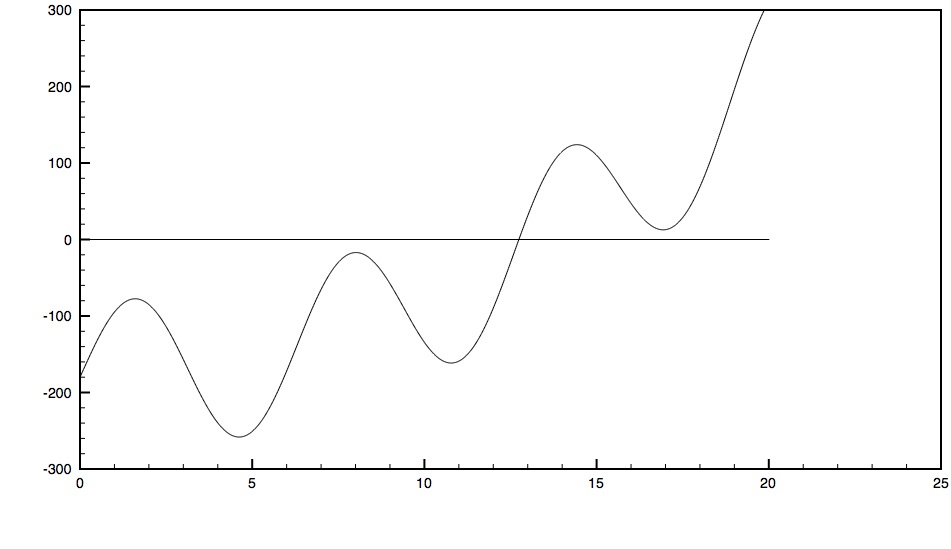MIDTERM II NOTES
Same rules and format as with midterm #1 (see top of this page for a list)
In general know:
- Integration
- Linear Systems (see this note on solving a linear system)
TOPICS
- Integration
- Trapezoid Rule
- Single 2-point interval & error term
- Composite form & error term
- Recursive form
- Romberg Integration (Richardson extrapolation) & error term
- Simpson's Rules
- single 3-point 1/3 interval & error term
- single 4-point 3/8 interval & error term
- Composite form & error term
- Gaussian integration
- Adaptive integration
- Monte Carlo methods
- random number generators, period, LCG
- Monte Carlo integration (v. uniform sampling)
- Linear Systems
- basics of linear systems of equations
- forward elimination, back substitution
- Matrices, properties, transpose, inverse, identity, determinant
- matrix representation of linear systems
- row, column operations on linear systems and corresponding matrix representation
- LU decomposition and associated complexity
SAMPLE QUESTIONS
- Given the function xxxx between 0 and 1, how well does the [Trapezoidal Rule using 1 inteval | 2-point Gaussian | ... ] compute the integral?
- What is 'recursive trapezoid integration'?
- What is adaptive integration?
- How many Trapezoid intervals are necessary to approximate an integral within 0.1 if the derivatives are bounded by .2 in the interval?
- Explain how to apply adaptive approach using Simpson's 1/3 rule.
- What are the important properties of random number generators?
- What is the period of an LCG?
- How would you use Monte Carlo integration to compute the area inside an oval?
- Given a system of linear equations,
- put it in matrix form,
- do forward elimination to convert A into an upper triangular matrix,
- perform back substitution to solve for the unknowns
- What is a permutation matrix and how does a given specific one affect a matrix?
FINAL EXAM NOTES
Same rules and format as with midterms (see top of this page for a list)
Bascially, this course is about how to do math on a computer paying particular attention to:
- number representations, approximation, error terms, error bounds
- order of complexity, convergence, robustness
- code optimization (e.g. Horner's method, Gaussian elimination issues)
To prepare for the final:
- Review the midterms and homeworks
- Also review the notes for the 2 midterms.
- Review problems from the book.
Topics
- Preliminaries
- Functions: continuity, derivative
- bases & conversions, fractional numbers, float point, double precision, fixed point representations, round-off errors (rep & calc), precision, accuracy, absolute & relative error, chopping v. rounding, significant digits
- Horner's method
- Taylor series, functions: continuity, derivative, Mean Value theorem, alternating series
- Root finding (convergence, robustness)
- factored form of functions
- Open v. closed methods
- Bisection, error, confergence
- Regula Falsi
- Newton's method, convergence rate
- Secant
- Interpolation
- Lagrange interpolation; Newton Form & divided differences, error term; uniqueness theorem, Chebyshev nodes
- splines: cubic piecewise; advantages relative to Lagrange/Newton; matrix form P(u)=UMB; Hermite, Catmul-Rom, blended parabolas, Bezier, B-spline - just general idea of each; continuity between segments
- Differentiation (TS)
- Taylor Series, truncation v. round-off errors
- Forward difference
- backward difference
- central difference
- Richardson extrapolation
- 2nd derivative approximation
- Integration (error terms)
- Reimann integrable function
- Trapezoidal method: composite, recursive: error term
- Romberg integration: order of error
- Simpson's rule: 1/3, 3/8: error term
- Gaussian quadrature: polynomial accuracy
- Adaptive approaches
- Monte Carlo integration, random number generators, LCG
- Systems of Equations
- Matrix manipulations: addition, multiplication, scaling, associative v. commutative, identity, transpose, inverse, determinant, complexity of operations, special matrices: symmetric, diagonal, upper triangular, lower triangular, banded
- Gaussian elimination: forward elimination, backward/forward substitution
- Matrix representation, permutation matrix, LU decomposition, MAx = Ux = Mb, Ax = LUx
- Pivoting, partial pivoting, scaled partial pivoting
- Computing inverse: AX = I
- Iterative methods: Jacobi, Gauss-Seidel, SOR - just the general idea, general form of the equation, and attributes of iterative methods. It's not necessary to know details of individual methods.
There will be questions on:
- Taylor series expansion and error term
- floating point format and round-off error
- Richardson extrapolation
- Scaled partial pivoting
SAMPLE QUESTIONS
See the sample questions from the midterms, above.
See the relevant sample exercises in the book (e.g., scaled partial pivoting)
- Give pseudo code to efficiently calculate x^5 + x^3 + x, for some given variable x.
- Give the three-term Taylor Series expansion of sin(x), where f'(x) = cos(x), f''(x) = -sin(x), f'''(x) = -cos(x), f''''(x) = sin(x). Also give a bound on the error.
- Show how the bisection method of root finding would work on the function graphed below.
- Derive the central difference formula using Taylor Series expansion.
- How is C-1 continuity enforced in Hermite splines?
- What does AB=BA tell you about the matrices?
- If A = LU, where L is a lower triangular matrix and U is an upper triangular matrix, explain how to solve Ax=b
Last updated 2/22/2012
CSE541 Class web page

